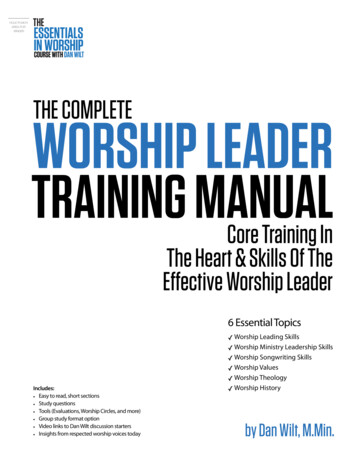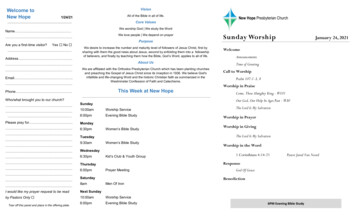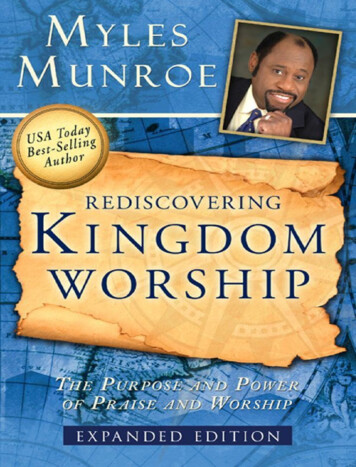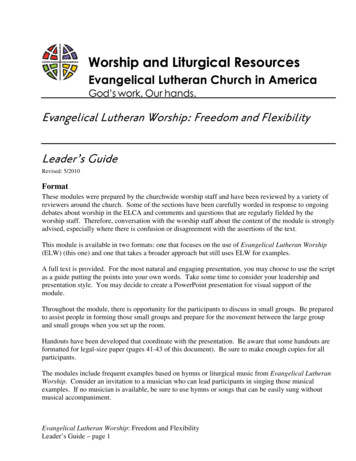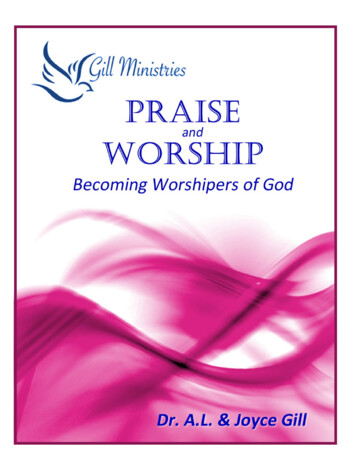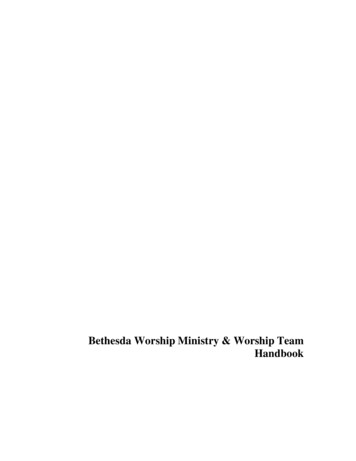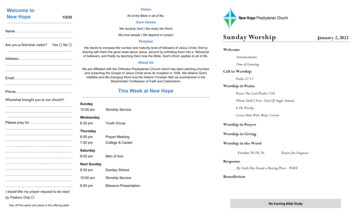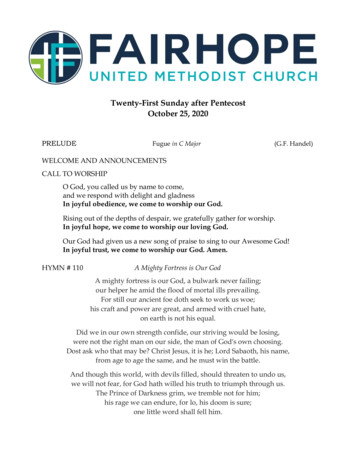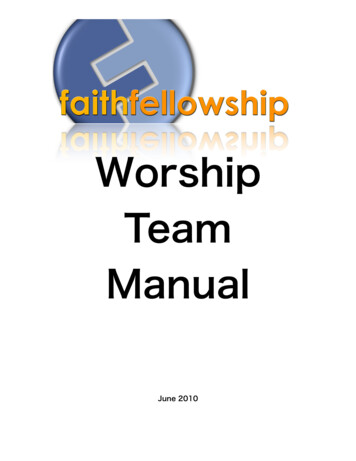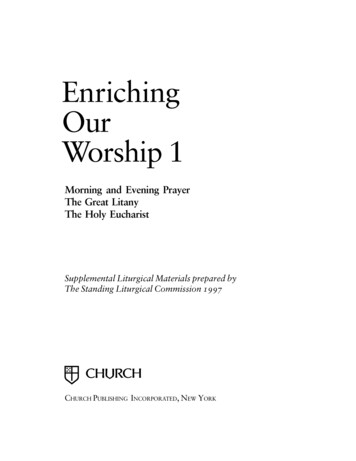
Transcription
EnrichingOurWorship 1Morning and Evening PrayerThe Great LitanyThe Holy EucharistSupplemental Liturgical Materials prepared byThe Standing Liturgical Commission 1997CHURCH PUBLISHING INCORPORATED, NEW YORK1
Copyright 1998 by The Church Pension FundPortions of this book may be reproduced by a congregation for itsown use. Commercial or large-scale reproduction, or reproductionfor sale, of any portion of this book or of the book as a whole,without the written permission of Church Publishing Incorporated,is prohibited.Church Publishing Incorporated445 Fifth AvenueNew York, NY 1001610 9 8 7 6 52
Contents5Preface7Introduction13The Use of Supplemental Liturgical Materials18Supplemental Liturgical Materials72Notes80Music for the Eucharistic Prayers3
4
PrefacebyThe Most Reverend Frank Tracy GriswoldEnriching Our Worship is offered by the Standing LiturgicalCommission to the Church through the General Convention as anenrichment of our liturgical prayer. This collection is part of anongoing process of listening to what the Spirit is saying to theChurch through the diverse experience of those who gather toworship and to celebrate the sacramental rites which fashion andidentify us as the People of god.Enriching Our Worship is not intended to supplant the Book ofCommon Prayer, but rather to provide additional resources toassist worshiping communities wishing to expand the language,images and metaphors used in worship. In some cases the canticles and prayers represent the recovery of ancient biblical andpatristic images, such as the identification of Christ with Wisdom, and in other cases images which speak of God in other thanthe familiar masculine terms which have been so much a part ofour liturgical prayer. Expanding our vocabulary of prayer andthe ways in which we name the Holy One bear witness to thefact that the mystery of God transcends all categories of knowing, including those of masculine and feminine.One of the considerations in choosing or developing the textsincluded in this collection has been the prayer experience ofwomen, and the desire to honor that experience while remainingfaithful to the constituent elements and norms of liturgical prayeras this Church has received and understood them. At all pointsalong the way in the process of selection and development oftexts the question has been asked: Is this text consistent with the5
Trinitarian and Christological formulations which we, as Anglicans, regard as normative and the ground of our commonprayer?The local use of Enriching Our Worship is subject to authorization by the Bishop, who serves as the Chief Liturgical Minister ofthe Diocese. In this way a pastoral bond can be maintainedwhich relates the local use of these texts to the worship life of thelarger Church.It is our hope that praying and singing the prayers and canticlesin this collection will deepen and strengthen our encounter withChrist and make it possible, with ever increasing conviction, tocry out with St. Ambrose, “You have shown yourself to me, OChrist, face to face. I have met you in your sacraments.”6
IntroductionIn 1789, the fledgling Episcopal Church, meeting in Philadelphia,adopted the first American Book of Common Prayer. Explainingits departure in certain respects from the BCP of the Church ofEngland, its preface observes thatIt is a most invaluable part of that blessed “libertywherewith Christ hath made us free,” that in hisworship different forms and usages may withoutoffense be allowed, provided the substance of the Faithbe kept entire.therefore, by common consent andauthority, may be altered, abridged, enlarged,amended, or otherwise disposed of, as may seem mostconvenient for the edification of the people, “accordingto the various exigency of times and occasions.”Since that historic decision, our Church has continued to seek anauthorized language of Common Prayer capable of expressingwhat we believe about God, as well as reflecting on our owncorporate and individual relationship to the Godhead. In formulating language for our prayers to the Trinity, we come to knowGod more closely. The decision to provide contemporary language rites in the 1979 Book of Common Prayer was a reaffirmation of the principles stated in that original American preface.The subsequent decade saw further efforts to produce supplemental rites in an American vernacular which would expand thelanguage and metaphors we use to speak of and to God. Thisexpansiveness has been more than an attempt to reflect currentconcerns with, say, gender issues or the transformation of society7
from a predominantly rural culture to an urban one; thoughassuredly it addresses these vital matters. Yet in trying to comecloser to our experiences of God throughout the ages, it alsooften returns to the resonant imagery of earlier periods in theChurch’s history —in particular the writings of the Early Church,along with the ecstatic evocations of the Medieval mystics—sometimes neglected by liturgies in recent centuries.In 1997, the General Convention of the Episcopal Church, againmeeting in Philadelphia, authorized Enriching Our Worship, thefourth edition of Supplemental Liturgical Materials. This newbook contains all the expansive language texts currently authorized, superseding all previous editions which should no longer beused. Inclusive/expansive language has developed considerablysince those early efforts published in Prayer Book Studies 30.Then as now, ears attuned to contemporary language and culturegrew uncomfortable with liturgical metaphors and forms ofaddress, inherited largely from the 18th and 19th centuries, inwhich God is primarily envisioned as a kind of Paterfamilias.However, the search for remedies has not been smooth. Bothpositive and negative reactions to early experiments emphasizedthat a substantial number of Episcopalians are most wary oflanguage which strikes them as abstract or depersonalizing(hence the widespread distaste for “Creator/Redeemer/Sanctifier” even among those who do not find the formulationmodalist). A fairly conservative fellow-parishioner once said tome, “I would rather call God ‘Mother’ than something neutral.”People frequently greet fresh images with enthusiasm when thoseexpressions seem illuminating—the new may well be absorbedmore readily than minor alterations in familiar texts. At thesame time, however, worshipers need to be able to relate unfamiliar words and metaphors to some context, so that the languageexpresses the prayer of the people of God. With some people, amajor sense of context will spring from life experiences; otherslook for continuity with biblical and ecclesiastical tradition.Keeping these various points in mind, the introduction to thenotes in this volume explains how the new texts draw upon someof the riches of scripture and the Christian tradition, which8
include an abundance of images of God. The committee soughtlanguage and imagery which would speak to the diversity ofpeople who worship in the Episcopal Church today, both thosewho are well steeped in the tradition and those whose knowledgeof scripture and the Christian tradition is fragmentary and towhom much traditional liturgical language is puzzling. The goalwas to employ evocative language which would lead worshipersdeeper into the mystery of God.Enriching Our Worship adds significantly to the body of textsalready available in the 1996 edition of Supplemental LiturgicalMaterials. Taking into consideration evaluations received fromcongregations who have used earlier editions, we have alsorevised certain texts, and removed those notes which seemed, inretrospect, to merely editorialize. Notes identifying sources, orcontaining substantive explanations helpful to the users, havebeen left intact. Where evaluations had indicated some confusionin celebrating the rite, annotations were appended for clarification. Following the practice of the 1991 and 1996 editions ofSupplemental Liturgical Materials, Enriching Our Worshipavoids supplying complete rites, providing instead a collection oftexts, any one (or several) of which may be incorporated into aRite Two Eucharist, Morning or Evening Prayer.In determining those directions new texts should take, we alsolooked at some recent, widely used materials from other branchesof the Church. In particular, we considered A New ZealandPrayer Book (1989), Celebrating Common Prayer (1992), andthe 1994 Psalter and Canticles produced by the Roman CatholicInternational Consultation on English in the Liturgy (ICEL).Consulting these three volumes, we borrowed directly or, incertain cases, adapted, 16 new canticles. Thirteen are taken fromscriptural sources. We have included such texts as “A Song of theWilderness” (Isaiah 35: 1-7, 10); “A Song of Jerusalem OurMother” (Isaiah 66: 10-14); “A Song of Our Adoption”(Ephesians 1:3-10); “A Song of God’s Love” (I John 4:7-11); and“A Song of the Heavenly City” (Revelation 21:22-26, 22:1-4). Inaddition, we have included three non-scriptural canticles: Anselmof Canterbury’s “A Song of Christ’s Goodness”; and two pas9
sages from Julian of Norwich—“A Song of True Motherhood”and “A Song of Our True Nature;” all three come from Celebrating Common Prayer. A table of “Suggested Canticles at Morningand Evening Prayer,” employing some of these offerings enrichesthe list in the 1979 Book of Common Prayer. A new version of theVenite directly addresses God in the manner of already availablevariants for The Song of Zechariah and The Song of Mary(ELLC). Also included is a fresh translation of The Song ofHannah, and a metrical version of the “Phos hilaron” (fromCelebrating Common Prayer). In both eucharistic and office rites,we have included, as an option for the conclusion of the lessons,“Hear what the Spirit is saying to God’s people” or “Hear whatthe Spirit is saying to the Churches”; to which the congregationmay respond, “Thanks be to God.” These options are based onChrist’s command to the seven Churches in Asia Minor from theBook of Revelation (2:29, 3:13, 22).The final item adapted from other sources is a contemporarylanguage version of “The Great Litany” (based on the textappearing in An Alternative Prayer Book, 1984, According tothe Use of the Church of Ireland and Celebrating CommonPrayer). The 1979 BCP continues to follow a longstandingtradition which substitutes, for those passages referring to theBritish Monarch, intercessions for “the President of the UnitedStates and all others in authority.” Some have felt that thisformulation does not really reflect the tripartite nature of ourcountry’s government. Therefore, the adapted version makesspecific mention of legislative, executive and judicialbranches, at national, state and local levels. The new versioncan be sung to the traditional chant. It is hoped that thiscontemporary version of the Litany may give many people afresh understanding of its petitions.Some new collects are derived from ancient sources like theGelasian Sacramentary, the Veronese Sacramentary, and Alcuinof York’s Mass of Wisdom. A short prayer by St. Gertrude theGreat marks the beginning of a project to include devotions bysome of the Mothers of the Church in the same way the BCP haspreserved prayers of St. John Chrysostom, St. Francis of Assisi,10
and other Church Fathers. A few collects are newly composed,employing some scriptural imagery underrepresented by whathas been currently available. All these may be used in place ofthe collect for the day, or, alternatively, post precum. One collectis borrowed from A New Zealand Prayerbook because it ties inwith creation imagery expressed in Job 38:4-11, which we haveused in a new eucharistic prayer.The language of this prayer is biblical in a characteristic Anglican mode, yet also conveys a contemporary intimacy in the wayGod is addressed. As the notes explain, its structure is patternedon the one Thomas Talley discerns underlyingthe diversity of classical eucharistic prayers in both theeastern and western liturgical traditions prior to theReformation.In this classical pattern of eucharistic prayer, praise tothe Creator leads into the Sanctus. This is followed bythanksgiving for redemption, climaxing in the narrativeof the institution and leading into a memorialoblation.Following this oblation, the prayer shifts tosupplication, with an invocation of the Holy Spirit uponthe bread and wine and upon the gathered community.To underscore that the institution narrative is part ofthe thanksgiving for redemption, this eucharistic prayerintroduces the institution narrative with the words “Wethank you.” To strengthen the unity of the thanksgivingfor redemption and the memorial oblation, an acclamation by the people follows the oblation and leads intothe supplication.In addition, a new confession of sin has been provided, alongwith two postcommunion prayers. Two concluding blessings havebeen taken from Celtic sources. A final one, from St. Clare, addsanother prayer from a Mother of the Church.The ultimate aim of expansive language experiments in theEpiscopal Church is to create a language of prayer for all God’speople. To this end, we consulted congregations who had used11
Supplemental Liturgical Materials in the past, but also reachedout to solicit a spectrum of opinion among Anglicans of manytraditions, including Anglo-Catholics, Evangelicals, andCharismatics (“Hear what the Spirit is saying to the Church” is aproclamation heard in certain Pentecostal traditions). The opinions of theologians, seminary and monastic communities, ecumenical liturgists and poets were also sought. Their commentshave been constructive, and influenced the shape of these texts.Enriching Our Worship marks only one more step in an ongoingprocess of development. Though much has been accomplishedduring the last decade, the development of expansive languageliturgies is still at an early stage. More remains to be done.Perhaps the greatest stumbling block to progress is a real shortage of feedback. Many in our Church have yet to encounterSupplemental Liturgical Materials, if they have even heard of it.Some of those who use, or have at least tried it, don’t bother toreport their reactions. Nor do groups engaged in writing newliturgies often share them with the Standing Commission onLiturgy and Music (the successor body to the Standing LiturgicalCommission and the Standing Commission on Church Music).Calls for such work often get little or no response. In order tofaithfully continue the process of discernment needed to developnew prayers expressing the worship of God’s people, the Standing Commission on Liturgy and Music needs to hear from allparts of the Church. And as we pray these new rites, we shouldremember the spirit of the injunction from the 1789 preface to thefirst American Book of Common Prayer, to receive and examinethem in a candid, charitable spirit, without prejudices or presuppositions, “seriously considering what Christianity is, and whatthe truths of the Gospel are,” asking the divine and eternal Wordfor words to best praise and petition our God who is the authorof all creation.Phoebe Pettingellfor the Standing Commission on Liturgy and Music12
The Use of SupplementalLiturgical MaterialsEnriching Our Worship contains texts intended to be explorationsfor the development of liturgical materials reflective of thediversity of the Church and looking forward to the disseminationthroughout the Church of a richer fabric of liturgical expression.Especially for congregations new to this material, a three-stepprocess will provide an ordered entry into the exploration. Thesteps are preparation, use and evaluation.1. PreparationAll liturgy is based upon a set of agreed-upon assumptions.Whenever those assumptions are altered, there is the possibilityof congregational reaction ranging from confusion to anger. Theintroduction of new liturgical texts demands careful preparationand pastoral sensitivity. Use of these prayers in any communitymust be accompanied by time for exploring issues raised by theiruse and time for reflection before, during and after their use inworship. One way to begin the introduction of the new texts is touse them with small groups who can study the texts before theyare used and begin to obtain some familiarity with them beforethey are used as a principal serviced on Sunday. Another strategy is to carefully announce the use of new texts at a regularlyscheduled congregational liturgy, simultaneously announcingopportunities to reflect on the experience in an atmosphere ofnon-threatening dialogue.Designing liturgies using supplemental liturgical materials willrequire careful and thorough planning. Decisions will have to be13
made as to what texts are to be used. There needs to be a conscious decision to use the texts long enough for worshipers togain some familiarity with the prayers. Texts need to be used fora sufficient period of time to determine which prayers engage,nourish, and sustain a particular community in its relationship toGod. Only after using the texts for a significant period of timecan the community discern their applicability to its prayer life.2. The Use of Supplemental Liturgical MaterialsSupplemental liturgical materials may only be used with thepermission of the diocesan bishop or, in the absence of the bishop,of the appropriate ecclesiastical authority. This authorizationhas a twofold purpose. First, it recognizes and affirms the bishopas the expression of unity in the life of the Church. Secondly, itprovides a point of dialogue for the ongoing experience anddevelopment of the rites. Liturgical development needs to bedone within the purview of the whole Church where there is aframework for theological reflection and dialogue.These materials are intended to be resources for the life of theChurch. The texts may be used in two very different ways. First,any of the texts may be used in conjunction with the Rite Twoliturgies of the 1979 BCP. For instance, the canticles may be usedin the context of a Rite Two Morning or Evening Prayer or as analternative to the Song of Praise in the Eucharist. Or, one of thesupplemental eucharistic prayers may be used with a Rite TwoEucharist. A second option is to develop an entire liturgy usingthe supplemental texts. The entire eucharistic liturgy can bedesigned with only the collect of the day from the BCP beingadded. Either of these options can be authorized for a principalSunday morning service.Decisions must be made on what materials need to be in thehands of the congregation. For a minimal application of the newtexts, a simple insertion of the text in a bulletin will suffice. Forthe circumstance in which an entire liturgy is built from newmaterials a complete service booklet will need to be developed.Copyright is extended to congregations for the reproduction ofthe texts included in Enriching Our Worship.14
Those who preside over the prayer of the community have aparticular responsibility to study and reflect upon the prayers.One needs to read and to meditate upon these texts prior tovoicing them as the prayer of the whole community.An Order for Celebrating the Holy Eucharist, found on page 400of the BCP, may also be used in conjunction with the “Forms forthe Eucharistic Prayer” in the supplemental materials. Thisoption provides a means whereby groups who wish to begin towrite their own prayers may use them in worship, except at theprincipal service on Sunday. New texts might include collects,forms for the prayers of the people, postcommunion prayers,canticles, etc. The “Forms for the Eucharistic Prayer” provide aframework of the traditional elements of a eucharistic prayerwhich can be used as a basis for new expressions of thanksgivingand praise.Congregations who may not have the gifts to compose extensivetexts might explore a few options which are flexible under therubrics of the BCP. The option to evolve prayers of the peoplewithin a congregation has been in place since the advent of the1979 BCP. A list of general intercessory categories can be foundon page 383 of the BCP, but the form and language of the intercession may be written in and for a local congregation. Gathering members of the congregation to write intercessory prayer anddevelop skills in the writing of texts is a creative way to engagethe life of the whole community. When crafting forms for intercessory prayer, it is recommended that a common congregationalresponse be used on a consistent basis, so that the text can easilychange from Sunday to Sunday. Further suggestions on theprayers of the people are found in Enriching Our Worship. Thecollect at the conclusion of the prayers of the people is not aprescribed collect. Those congregations who are in the process ofdeveloping prayers may use this opportunity to explore newoptions.Music is a major consideration in designing any liturgy. Hymntexts offer diverse ways to speak of God. There is a body ofhymnody in The Hymnal 1982 which expands our language for15
God and is consistent with the supplemental texts in regard toreferences to human beings. For instance, Hymn 371 praises theHoly Trinity in non-gender-related language. Often metricalsettings of psalms and canticles reflect modern linguistic changesand are appropriate when designing liturgies using the supplemental texts. Wonder, Love and Praise, a supplement to TheHymnal 1982, recently published by Church Publishing, Inc.,adds considerably to the diversity of musical material availablefor liturgical use. Music is also available for Eucharistic Prayers1, 2 and 3 in this volume.Even though women are included as ordained ministers and aslectors, intercessors, and acolytes, they still are all too ofteninvisible in our worshiping communities. The choice of lectionaryreadings in the Episcopal Eucharistic Lectionary has often deletedor diminished the place of women in salvation history. TheRevised Common Lectionary is authorized for trial use. Thislectionary seeks to expand the scripture appointed for the SundayEucharist to include passages which reflect the faithful witness ofwomen. Congregations using the supplemental materials mightexplore the use of this lectionary.The context in which the supplemental liturgical materials areused will shape the experience of these prayers. Non-verballanguage—the language of gesture, movement, sign—will alwaysoverride the text of the prayer. Therefore, care needs to be takenon the setting of these prayers. Liturgical ministry should reflectthe fullness of the worshiping community.3. EvaluationAll liturgical texts are rich in what they say about God but alsowhat they say about ourselves in relationship with God. This is atthe heart of any theological reflection upon the experience ofliturgical prayer. Who does the text say God is, who does it saywe are, and—most importantly—what does this mean for us?These questions form the basis upon which the community canexplore how these prayers speak in the hearts, minds, and spirit16
of the community of faith.You are encouraged to communicate your experience of thesematerials to the Office for Liturgy and Music at the EpiscopalChurch Center, 815 Second Avenue, New York, NY 10017. Theoffice is especially interested to receive materials written locally,for a particular congregation’s worship. It is only as materialsare collected and evaluated that the whole Church will begin tohave prayers which expand the breadth and depth of theChurch’s prayer life.A View to the FutureThe task for the Church is not merely to translate but to find thevoice of prayer in the heart, spirit and mind of the people praying.The process of enriching our prayer is by nature an extendedprocess requiring use, evaluation and theological reflection. As theprocess unfolds, new questions are raised and new avenues ofexpression are disclosed. General Convention Resolution C021sdirects the Standing Commission on Liturgy and Music toprepare a plan for liturgical revision and enrichment of thecommon worship of this Church. The resolution also directsthe commission to consider the Church’s.multicultural,multiethnic, multilingual andmultigenerational.constituency, in the process of.providingrites and structures that ensure the unity of Common Prayer.This is not a task the commission can complete without the helpof local worshiping communities. Whatever we imagine thefuture of the Book of Common Prayer to be, the task in themonths and years to come is to compose, use, evaluate anddistribute a wide variety of emerging resources. You are invitedto share in that process.17
Morning and Evening PrayerOpening SentencesAdventArise, O Jerusalem, stand upon the height and look toward theeast, and see your children gathered from west and east at theword of the Holy One. Baruch 5:5AdventShower, O heavens, from above, and let the skies rain downrighteousness; let the earth open, that salvation may spring up,and let it cause righteousness to sprout up also. Isaiah 45:8, NRSVChristmasThe Word became flesh and dwelt among us, full of grace andtruth. John 1:14LentJesus said: “If any of you would come after me, deny yourselfandtake up your cross and follow me.” Mark 8:34Holy WeekChrist Jesus, being found in human form, humbled himself andbecame obedient unto death, even death on a cross.Philippians 2:8EasterIf anyone is in Christ, there is a new creation: everything old haspassed away; see, everything has become new! 2 Corinthians 5:17,NRSV18
Occasions of ThanksgivingWe give you thanks, O God, we give you thanks, calling uponyour Name and declaring all your wonderful deeds. Psalm 75:1All Saints and Major Saints’ DaysYou are no longer strangers and sojourners, but citizens togetherwith the saints and members of the household of God.Ephesians 2:19At Any TimeGod is Spirit, and those who worship must worship in spirit andin truth. John 4:24ConfessionThe Deacon or Celebrant saysLet us confess our sins to God.Silence may be kept.Minister and PeopleGod of all mercy,we confess that we have sinned against you,opposing your will in our lives.We have denied your goodness in each other,in ourselves, and in the world you have created.We repent of the evil that enslaves us,the evil we have done,and the evil done on our behalf.Forgive, restore, and strengthen usthrough our Savior Jesus Christ,that we may abide in your loveand serve only your will. Amen.19
AbsolutionAlmighty God have mercy on you, forgive you all your sinsthrough the grace of Jesus Christ, strengthen you in all goodness,and by the power of the Holy Spirit keep you in eternal life.Amen.Opening VersicleMorning PrayerOfficiantPeopleO God, let our mouth proclaim your praise.And your glory all the day long.Evening PrayerOfficiantPeopleO God, be not far from us.Come quickly to help us, O God.DoxologyPraise to the holy and undivided Trinity, one God: as it was in thebeginning, is now, and will be for ever. Amen.Except in Lent addAlleluia.Antiphons on Venite or JubilateIn AdventOur God and Savior now draws near: O come let us worship.From the Epiphany through the Baptism of Christ, and on theFeasts of the Transfiguration and Holy CrossChrist has shown forth his glory: O come let us worship.In LentOur God is full of compassion and mercy: O come let us worship.20
or thisToday, if you would hear God’s voice: harden not your hearts.From Easter Day until the AscensionAlleluia. Christ is risen. O come let us worship. Alleluia.On Trinity SundayThe holy and undivided Trinity, one God: O come let us worship.On other SundaysChrist has triumphed over death: O come let us worship.On other Sundays and WeekdaysGod is the Rock of our salvation: O come let us worship.or thisThe Holy One is in our midst: O come let us worship.On All Saints and other Major Saints’ DaysThe bracketed Alleluias in this Antiphon are used only in Easter Season.[Alleluia.] Our God is glorious in all the saints: O come let usworship. [Alleluia.]Invitatory PsalmsVenite Psalm 95:1-7Come, let us sing to the Lord; *let us shout for joy to the Rock of our salvation.Let us come before God’s presence with thanksgiving *and raise to the Lord a shout with psalms.For you are a great God; *you are great above all gods.In your hand are the caverns of the earth, *and the heights of the hills are yours also.21
The sea is yours, for you made it, *and your hands have molded the dry land.Come, let us bow down and bend the knee, *and kneel before the Lord our Maker.For you are our God,and we are the people of your pasture and the sheep of your hand. *Oh, that today we would hearken to your voice!The following verses are added when Psalm 95 is used as the Invitatory:Let us listen today to God’s voice:Harden not your hearts,as your forebears did in the wilderness, *at Meribah, and on that day at Massah,when they tempted me.They put me to the test, *though they had seen my works.Forty years long I detested that generation and said, *“This people are wayward in their hearts;they do not know my ways.”So I swore in my wrath, *“They shall not enter into my rest.”Morning PsalmsIn place of an Invitatory Psalm, one of the following Morning Psalmsmay be sung or said.Suggested Antiphons for use with these Psalms will be found on page 24.Psalm 63:1-8 Deus, Deus meusO God, you are my God; eagerly I seek you; *my soul thirsts for you, my flesh faints for you,as in a barren and dry land where there is no water.Therefore I have gazed upon you in your holy place, *that I might behold your power and your glory.For your loving-kindness is better than life itself; *my lips shall give you praise.22
So will I bless you as long as I live *and lift up my hands in your Name.My soul is content, as with marrow and fatness, *and my mouth praises you with joyful lips,When I remember you upon my bed, *and meditate on you in the night watches.For you have been my helper, *and under the shadow of your wings I will rejoice.My soul clings to you; *your right hand holds me fast.Psalm 67:1-5 Deus misereaturO God, be mercifu
sages from Julian of Norwich—"A Song of True Motherhood" and "A Song of Our True Nature;" all three come from Celebrat-ing Common Prayer. A table of "Suggested Canticles at Morning and Evening Prayer," employing some of these offerings enriches the list in the 1979 Book of Common Prayer. A new version of the
